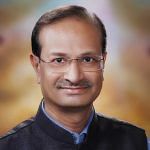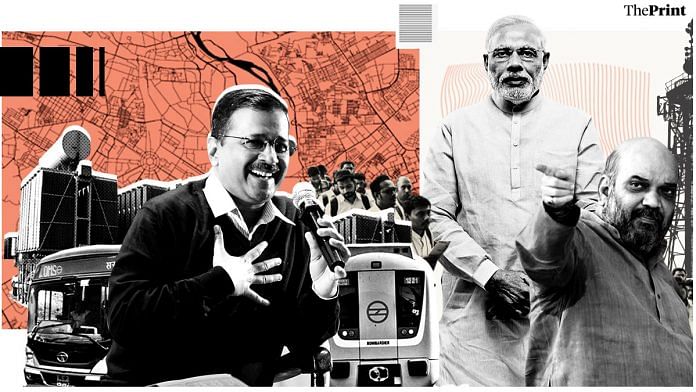Delhi CM Arvind Kejriwal has toned down his angry political rhetoric against BJP and Congress leaders ahead of the 2020 assembly election campaign, focusing instead on his government’s work. Home Minister Amit Shah and PM Narendra Modi have raised issues of Pakistan, CAA and JNU student politics.
ThePrint asks: A toned-down Kejriwal or aggressive Modi-Shah: who has wider appeal in Delhi elections?
Kejriwal’s leadership, Congress’ decline, and AAP govt’s work will determine 2020 Delhi assembly election
 Ashutosh
Ashutosh
Former AAP member
Arvind Kejriwal used to give lots of public speeches but the work that his government has done for the people can now speak for itself. Three factors will define the upcoming Delhi assembly election — Kejriwal’s leadership, Congress’ decline, and the work done by the AAP government.
Unlike the AAP, the BJP is leaderless. It has no one who can challenge Kejriwal in terms of charisma, stature, and social base. Moreover, the recent assembly elections in Haryana, Maharashtra, and Jharkhand clearly show that the BJP’s aggressive, nationalist politics do not create local leadership.
Last year, the Congress did better than the AAP in municipal and parliamentary elections, but the demise of Sheila Dikshit has left the Congress equally leaderless. Its entire social base has been usurped by the AAP. The trend is that a strong Congress in Delhi is a boon for the BJP while a weak Congress is a boon for the AAP.
It’s also important to remember that Delhi is a unique administrative system where the municipal corporation, MPs, law and order, and land are controlled by the BJP whereas assemblies are controlled by the AAP. This way, voters can distinguish between the work done by the Kejriwal government and by the Modi government at the Centre.
Lastly, let’s not confuse the AAP today with the AAP of 2013. Back then, it was a product of a movement with an element of idealism. It was seen as unique. Today, it’s like any other political party in India.
Both Kejriwal and Modi-Shah are liked by people but a toned-down Delhi CM is clearly preferred
 Sanjay Kumar
Sanjay Kumar
Professor and Director, CSDS
The results of the 2020 assembly election will best judge whether a toned down Arvind Kejriwal or the aggressive Modi-Shah duo has wider appeal in Delhi.
My own sense is that both Arvind Kejriwal and Modi-Shah duo are equally liked by the people of Delhi who are aware that they are cut out for different roles. As someone in-charge of governing Delhi, Kejriwal is liked more than Narendra Modi and Amit Shah – whether aggressive or toned down, although I am sure a toned-down Kejriwal is preferred because that puts him across as someone serious about Delhi’s development.
People initially judged Kejriwal for his style and behaviour, but of late, he has been evaluated on the basis of the work done, especially in the field of education and health.
But in terms of national politics, the same Kejriwal pales in comparison to Modi-Shah, who are far more popular than the Delhi CM because of the work they have done in the last few years – the abrogation of J&K’s special status, triple talaq law, push for Ram Mandir, and the Citizenship (Amendment) Act. What makes Modi and Shah even more popular among the people of Delhi is the aggressive style in which they put their arguments – either in support of their government’s policies or to criticise the Congress and other opposition leaders.
But it remains to be seen whether people will vote for the BJP based on Modi-Shah’s popularity or on the work done by the Kejriwal government.
Lower and middle-class benefitted from AAP’s welfare schemes. But wealthy may fall for BJP’s polarisation
 Neelanjan Sircar
Neelanjan Sircar
Assistant professor, Ashoka University & Visiting senior fellow, Centre for Policy Research
To get a sense of who is likely to win the Delhi assembly election, we can’t just look at the demeanor of each party’s leadership. What’s critical are the issues they stand for.
For the AAP and Kejriwal, the focus is likely to be on the work they have done for the people of Delhi, especially the poor. Their campaign will be centered on the success of welfare schemes that the government was able to implement despite various constraints due to Delhi being a union territory.
On the other hand, the BJP and the Amit-Shah duo will most likely try to polarise Delhi’s electorate and ask them to vote as per social and religious preferences. Their focus will be on identity politics.
A large section of Delhi’s population belongs to the lower and middle-class who directly benefited from the Kejriwal government’s various welfare schemes — be it electricity, water, health, public education or buses. People from these groups have seen a change in their daily lives. The upper-class and the wealthy, who have not been as impacted by the schemes directly, may be more vulnerable to the BJP’s strategy of polarisation.
Opposition leaders can learn electoral pragmatism from Arvind Kejriwal, who has kept his politics regional
 Yashwant Deshmukh
Yashwant Deshmukh
Founder-director, CVoter International
Arvind Kejriwal has become more pragmatic. He has not fallen into the trap of a Left-liberal narrative, leaving the BJP unable to brand him an “Urban Naxal” along with other opposition parties.
The reason he hasn’t taken a strong stance on the CAA and chose not to show up at the JNU after the attack is because he knows that a majority of the AAP’s voters are pro-CAA. Remember that he also voted in favour of Article 370’s dilution and continues to use ‘Bharat mata ki jai’ in his speeches.
Since 2014, Kejriwal has kept his politics regional and focused on issues in Delhi, unlike other opposition parties who were unable to read the politics on the ground. They fought the BJP in the name of secularism while diluting the sentiments of India’s majority. And then they confuse their occasional electoral success as confirmation of their ‘secular’ stand. For example, the Congress’ piggy-backing in the Maharashtra and Jharkhand elections shows they have confused their electoral performance as a ‘secular stamp’ from the voters. But they continue to be electorally insignificant.
The moment Kejriwal will speak against the CAA, he will risk his chances of electoral victory. His priority is winning the Delhi assembly election and sustaining power without allowing the BJP to polarise voters. He is a smart person. Other opposition leaders could perhaps learn electoral pragmatism from Arvind Kejriwal.
Delhi assembly election purely a test of Kejriwal’s mandate, not a competition with Modi
 Pradeep Bhandari
Pradeep Bhandari
Psephologist
No election in India has been won on the basis of ‘anti-Congress’ or ‘anti-Modi’ wave because voters do not respond to negativity. Look at what happened in the 2019 Lok Sabha election, when all opposition parties put up an ‘anti-Modi’ campaign. The BJP ended up winning with a huge mandate.
From the time Arvind Kejriwal stopped attacking Narendra Modi, the AAP’s image took a positive turn, with the work done by the Delhi government coming at the forefront. This is crucial because the upcoming assembly election is purely a test of Kejriwal’s mandate, not one based on a competition with Modi. There will either be pro-Kejriwal or anti-Kejriwal voters, and the CAA or attack on Jamia Millia Islamia and JNU will not be a major electoral issue.
Past instances have shown that the BJP cannot do well in elections unless the Congress also performs well. In 2013, when the AAP‘s popularity was on the rise, it won 28 out of 70 assembly seats while the Congress got eight seats. In 2015, the Congress’ vote share fell from 24 per cent to 8 per cent. The BJP’s vote share didn’t change.
This year, it is unlikely for the BJP’s vote share to reach 40 per cent or more. If anything, this is the first election where the BJP should hope the Congress does well.
Also read: NRC, NPR, CAA: Is the Modi govt facing a serious trust deficit?
By Pia Krishnankutty, journalist at ThePrint







In a competitive market situation ,what helps one is putting the strong points of your product to the public rather than reacting to he
opponents product’s pitfalls or weaknesses. Since the consumer is clear what he wants and he can judge who can deliver his needs,
the stronger product will win the market share.
Too much support for a weak product is bound to backfire on it ,as people will see it as superfluous and wasted effort.
AAp and it CEO knowing their cards ,can play down the opposition easily winning a handsome majority.
Well absurdity of Indian media is on display. How many commentator have spent time in any international city on their own expense or have ground level Gandhian experience if you want your way. Other metros do not have this liberty as they are hostage to host state but not Delhi. But print, really shaking Shekar gupta cannot think economics, foreign affairs or even macro or micro economics. When we have these boozos who cannot mould public opinion outside ideological construct in such a small area of Delhi then thay should be humble enough to understand they are supporting cast at best …and not masters of the Universe as they seem to think.
Ye dil toned-down mangta. However, JUST ENOUGH majority to keep Mr. Kejriwal in the CM’s seat, and therefore grounded, as he has a record of behaving erratically. No coalition please; anything left after majority ideally should split between BJP and Congress. confining both parties to the opposition benches. That will surely make an interesting Delhi assembly, and truly become a litmus test for Kejriwal.
At some stage, the orbits of national and state level verdicts will begin to intersect. Several issues are salient to voters across what has been considered a natural psephological divide, starting with the economy. Basic governance too is looking wobbly.
The answer is blowin’ in the wind : 59 – 8 – 3.
My guess is 80%, 15% and 5% seats of course.